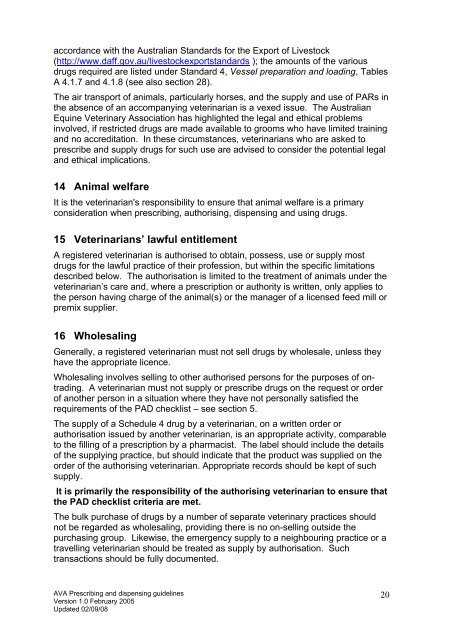Guidelines for Prescribing, Authorising and Dispensing - Australian ...
Guidelines for Prescribing, Authorising and Dispensing - Australian ...
Guidelines for Prescribing, Authorising and Dispensing - Australian ...
You also want an ePaper? Increase the reach of your titles
YUMPU automatically turns print PDFs into web optimized ePapers that Google loves.
accordance with the <strong>Australian</strong> St<strong>and</strong>ards <strong>for</strong> the Export of Livestock<br />
(http://www.daff.gov.au/livestockexportst<strong>and</strong>ards ); the amounts of the various<br />
drugs required are listed under St<strong>and</strong>ard 4, Vessel preparation <strong>and</strong> loading, Tables<br />
A 4.1.7 <strong>and</strong> 4.1.8 (see also section 28).<br />
The air transport of animals, particularly horses, <strong>and</strong> the supply <strong>and</strong> use of PARs in<br />
the absence of an accompanying veterinarian is a vexed issue. The <strong>Australian</strong><br />
Equine Veterinary Association has highlighted the legal <strong>and</strong> ethical problems<br />
involved, if restricted drugs are made available to grooms who have limited training<br />
<strong>and</strong> no accreditation. In these circumstances, veterinarians who are asked to<br />
prescribe <strong>and</strong> supply drugs <strong>for</strong> such use are advised to consider the potential legal<br />
<strong>and</strong> ethical implications.<br />
14 Animal welfare<br />
It is the veterinarian's responsibility to ensure that animal welfare is a primary<br />
consideration when prescribing, authorising, dispensing <strong>and</strong> using drugs.<br />
15 Veterinarians’ lawful entitlement<br />
A registered veterinarian is authorised to obtain, possess, use or supply most<br />
drugs <strong>for</strong> the lawful practice of their profession, but within the specific limitations<br />
described below. The authorisation is limited to the treatment of animals under the<br />
veterinarian’s care <strong>and</strong>, where a prescription or authority is written, only applies to<br />
the person having charge of the animal(s) or the manager of a licensed feed mill or<br />
premix supplier.<br />
16 Wholesaling<br />
Generally, a registered veterinarian must not sell drugs by wholesale, unless they<br />
have the appropriate licence.<br />
Wholesaling involves selling to other authorised persons <strong>for</strong> the purposes of ontrading.<br />
A veterinarian must not supply or prescribe drugs on the request or order<br />
of another person in a situation where they have not personally satisfied the<br />
requirements of the PAD checklist – see section 5.<br />
The supply of a Schedule 4 drug by a veterinarian, on a written order or<br />
authorisation issued by another veterinarian, is an appropriate activity, comparable<br />
to the filling of a prescription by a pharmacist. The label should include the details<br />
of the supplying practice, but should indicate that the product was supplied on the<br />
order of the authorising veterinarian. Appropriate records should be kept of such<br />
supply.<br />
It is primarily the responsibility of the authorising veterinarian to ensure that<br />
the PAD checklist criteria are met.<br />
The bulk purchase of drugs by a number of separate veterinary practices should<br />
not be regarded as wholesaling, providing there is no on-selling outside the<br />
purchasing group. Likewise, the emergency supply to a neighbouring practice or a<br />
travelling veterinarian should be treated as supply by authorisation. Such<br />
transactions should be fully documented.<br />
AVA <strong>Prescribing</strong> <strong>and</strong> dispensing guidelines<br />
Version 1.0 February 2005<br />
Updated 02/09/08<br />
20

















